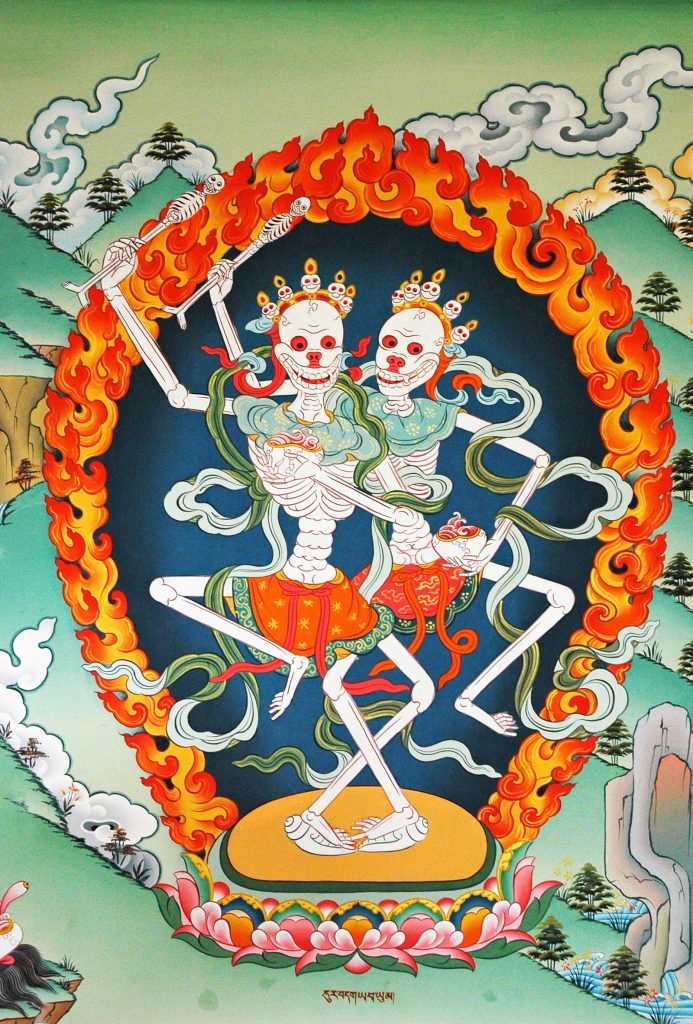Today is Halloween, and here’s the chilling secret: Buddhism loves ghosts. And not just the hungry kind. Demons, spirits, and other supramundane creatures abound in the Buddhist canon, and they continue to play a role in the lives of many Buddhist practitioners today.
To some skeptics, all those ghoulish beings are just psychological tropes, mere projections of an unenlightened mind. But like any good teacher, the things that go bump in the night have a way of upending our notions about what we hold to be real and unreal.
So, fill your oryoki bowls with mini Milky Ways, and descend into the hellish and haunted realms, with these seven articles from our archives that highlight the mysterious roles that monsters, specters, ghosts, and zombies played in Buddhist traditions throughout history. For the easily frightened, we also include a selection of articles about overcoming fear through meditation and Buddhist teachings. Happy Halloween!
Buddhist Halloween Horrors
- The Monsters of Buddhism—Inside and Out by Julia Hirsch
An abridged guide to Buddhist monsters and the lessons they hold about the possibility of transformation—such as the child-eating Kishimojin, who eventually purifies her karma and becomes the Buddha-endorsed guardian deity of mothers and children. Alternatively, a horror movie with a happy ending. - How to Watch a Thai Ghost Movie by May Cat
A Thai cinephile writes about the karma-fueled haunting of the 2009 Thai horror flick Novice. A young man ordains as a novice monk, but is tormented by the misdeeds of his past. In the end, the monk gets his due, and the hungry ghosts doom him to life as one of their own. - Ghosts, Gods, and the Denizens of Hell by Donald Lopez, Jr.
Buddhist studies scholar Donald Lopez Jr. provides an introduction to the six realms—including the less than desirable sectors of existence. “There are eight hot hells and eight cold hells, four neighboring hells, and a number of trifling hells,” he writes, reminding us that even though human existence is tough, it’s still the best (and only) shot we have at freedom from samsara. - Treasury of Lives: Halloween Edition by Harry Einhorn
Tibetan cosmology is populated with interesting paranormal creatures, like deloks—people who died, visited the lower realms, and returned to warn those in the human realm about the punishments that awaited them unless they started walking an ethical path. Also in Tibetan Buddhism is a model of fear-facing Buddhist practice in the female master Machik Labron (1055–1149), who encouraged her students to do chöd, tantric practice in burial grounds and other spooky places. - The Old Human Demoness by Chokey Dolma
This haunting tale by Chokey Dolma showcases the richness of Tibetan ghost stories. Once upon a time, a young monk disobeys his teacher’s order to buy meat only as given without asking for more, and he becomes marked by evil spirits. To avoid becoming demon food, the young monk travels to Lhasa and requests the aid of a mysterious old woman. Although she agrees to help hide him from the demons, the young monk eventually discovers there is more to this woman than meets the eye. - Bringing Hungry Ghosts Out of Hiding, Andy Rotman in conversation with Julia Hirsch
Andy Rotman, a scholar of South Asian religions at Smith College and one of the few academics researching the history of hungry ghosts, explains what the most wretched beings of the Buddhist cosmos can teach us about greed, suffering, and the dharma. - Into the Demon’s Mouth, by Aura Glaser
Through a modern retelling of the Buddhist story of the great Tibetan saint Milarepa and the demons who inhabited his cave, Glaser invokes Carl Gustav Jung, Chögyam Trungpa Rinpoche, and others to illustrate how remaining present among difficult life situations can help us to work with problems and to even learn from them. A parable with elements of horror, Glaser’s writing opens up the story so that we can learn to face our fears with clarity and kindness.
Fear
- Harnessing Horror Through Meditation by Biju Sukumaran
After getting stuck on Disneyland’s Space Mountain ride as a child, Biju Sukumaran has had a phobia of heights and small spaces. Recently, he started drawing from the Buddhist practices of vipassana (insight) and Tibetan chöd meditation to face his fears of flying, horror movies, and, yes, even roller coasters. - A Safe Container for Fear by Josh Korda
What does fear feel like in the body? Approaching feelings of unease, anxiety, and social discomfort with questions like these, Josh Korda suggests, can help untangle the web of fear we weave for ourselves. - Facing Fear by Lama Tsony
Coming back to the focal point of meditation (the breath, posture, or a visualization) can help us practice and move through our fears, Lama Tsony writes. Taking refuge or seeking guidance from a spiritual teacher or friend offers the support we need as we explore the uncomfortable zones of our minds. - The Terror Within by Zenju Earthlyn Manuel
In a meditation on the different ways fear has come up in her own life and practice, Zen priest, author, and artist Zenju Earthlyn Manuel uses lessons from the Heart Sutra and the Buddha’s teachings on the five hindrances to provide steps for breaking out of cycles of anxiety and to acknowledge the roots of our fear as a conditioned state that is accumulated over a lifetime. By providing steps for breathing into these feelings and releasing them, Manuel invites readers not to hide from their fear but to embrace it as an act of liberation.
⧫
This article was originally published on October 31, 2019.
Thank you for subscribing to Tricycle! As a nonprofit, we depend on readers like you to keep Buddhist teachings and practices widely available.
